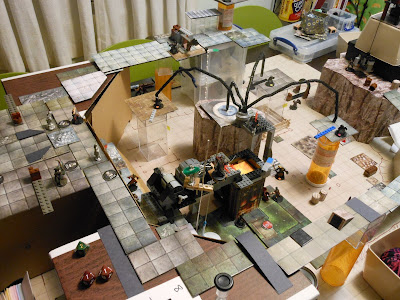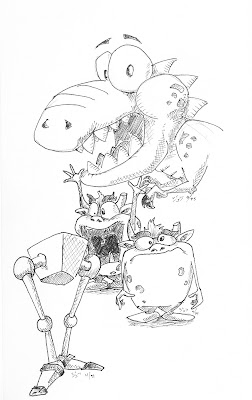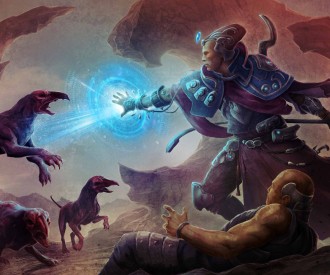Happy Friday everyone! This is the fourth post in my ongoing series about getting started with RPGs from the perspective of a busy adult. If you haven't already, you might also want to check out
part 1,
part 2 and
part 3 of this series.
Today, we will tackle the challenge of gaming on a busy schedule. To that end, I am writing this while on my lunch break at work. How apt.
The first thing I will say to those of you concerned about whether you can fit gaming into your busy schedule. IT CAN BE DONE! When I first returned to gaming as an adult, I was balancing a full schedule of grad school and work. Now I am actually running a game while also working full time and helping my fiancée plan our wedding this summer. The fiancée, who is also one of my players, has a very demanding job, takes ballet and yoga classes and is shouldering most of our wedding planning tasks. I have players who went through grad school or college while playing in the group. All hold down jobs and have very busy extra-curricular lives that involve, among other things, spouses, gardening, sports watching, tutoring, dancing, skiing, Rubix cube solving (like on an internationally competitive level)...and on and on. We. are. busy. Yet we still find time to game.
How do we do it? I'll get to that. First, I need to go over how much time it actually takes to game. The commitment for players is fairly straightforward. In most groups, the players just need to show up on game night ready to play with their character sheets and dice in hand. That's it.
The actual time involved to achieve this depends on the structure of your sessions. Do you play weekly? bi-weekly? Do you do an all day binge one weekend a month? Figuring out the schedule for your game sessions (how long and how often you play) is something that should be hashed out with everyone in the group participating. In general, though I suggest a minimum of 3 hours play time per session (enough to get through 1 or two encounters) with sessions scheduled weekly, bi-weekly or monthly. If you can swing it, you'll get a lot more done in 4-6 hours, but that might not be doable on a busy schedule.
For the GM, the time commitment is typically much greater than for the players. When I was first starting out, I read several articles stating that you should be able to plan a 4 hour game in 1 hour. After four years of GMing, I have yet to hit that mark. Most of my planning time involves scratching my head about what I actually want to do. Once I get down to writing, then it might only take an hour, but there is a lot more brain time involved. In general, I probably spend 4-8 hours a week working on game prep. Now, this time could be significantly shorter if I were running a pre-published setting and/or adventure.
Now for the nuts and bolts of managing game time.
1. Acknowledge that real life comes first!
It may seem odd to have to say it, but I often have to pause and remind myself that it is just a game. People get too busy to play, have last minute things come up, get sick, go on vacation, work late, get stuck in traffic. Real life intervenes on a regular basis and it is important to remember what takes priority. If everyone in the group is respectful and understanding of this fact, chances are, you will do a much better job of finding time to play.
2. Have a clear, consistent schedule
Keeping a busy group rolling requires a predictable schedule. How often will you play? How long will you play during each session? Do you have a hard stop time or do you play until you reach a stopping point? Will there be food? All of these questions are important to answer so busy players can work game night into their schedule with confidence that it wont intrude on other commitments (see rule 1) We play from 6 to 10 pm every other week. Our sessions start with about an hour of dinner and social chatter before the game actually starts around 7 pm. We try to keep our game night on the same night each week, though it has bounced back and forth between Wednesdays and Thursdays over the years before recently shifting to Mondays.
For busy groups, I would recommend avoiding weekly games. This leads to GM and occasionally player burnout. On the flip side, if you leave too much space between sessions, players can lose the continuity of the story and much of your time will be spent recapping what happened.
3. Be Flexible
The other side of having a clear schedule is knowing if and when to change that schedule. This involves two things. Dealing with the temporary disruption of absent players, and dealing with longer-term schedule changes. I have said this before. One of the most valuable things I did for my game was to establish clear rules for handling absent players. We only cancel a game if half or fewer of the group can make it to game night. If that is the case, we first try to find an alternate day. If that doesn't work, we cancel.
For longer term schedule changes like someone shifting work hours, it is important to have a way for the group to discuss an alternate schedule. I like to use a
Doodle survey in such situations. This allows me to clearly see who can make which days/hours and to adjust things in order to benefit the largest portion of the group.
If you stick to these three rules for running a game, the time commitment should be fairly similar to taking a class, playing a sport or being involved in any other regularly scheduled activity. For a GM, it is actually going to be more like coaching a regularly scheduled activity, but because this post is starting to run long, I will address the rare and peculiar beast that is timely game prep in a later post.


































